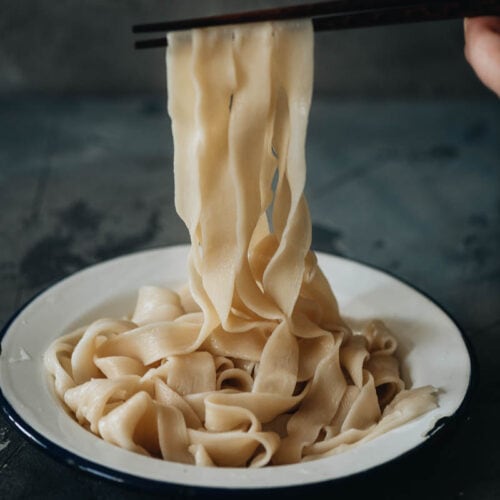Chinese Hand Pulled Noodles Recipe
Chinese hand-pulled noodles, la mian, date back over 2,000 years. These noodles originated in China during the Han dynasty (206 B.C. to 220 A.D.) and have since held significant cultural value. In regions like Lanzhou, they symbolize longevity, making them popular during celebrations like birthdays and New Year’s. La mian’s traditional preparation process not only showcases culinary artistry but also embodies the rich history and customs of Chinese cuisine.
Evolution and Regional Variations
La mian have evolved across centuries, reflecting regional differences in China. In the north, noodles are often thicker and paired with hearty, meat-based broths, while southern regions prefer thinner noodles with lighter, seafood-based soups. Lanzhou’s beef noodle soup, a famous dish, highlights the local version of hand-pulled noodles. Each region adapts la mian to its local ingredients, creating unique culinary experiences distinct to their cultural contexts.
Ingredients and Preparation
Key Ingredients Used
Chinese hand-pulled noodles rely on simple yet essential ingredients. These include:
- Flour: Use high-gluten flour for its strong elasticity, which is necessary for the stretching process.
- Water: Adjust the water temperature, with room temperature being the most common choice.
- Salt: Add a small amount to strengthen the dough.
- Oil: Use as a coating to prevent dough from drying out during resting.
These basic components create a dough that’s flexible and resilient, enabling the distinctive pulling and twisting unique to la mian.
The Art of Dough Pulling
Masters of la mian employ precise techniques to pull the dough into thin, uniform strands. Start with these steps:
- Kneading: Mix flour, water, and salt, kneading until the dough is smooth and pliable. Rest the dough for at least 30 minutes.
- Dividing: Split the dough into smaller portions for easier handling.
- Stretching: Hold both ends of the dough piece, pulling gently to elongate. Fold the dough in half and continue pulling, repeating the process several times.
- Twisting: Twist the dough while pulling to create even noodles. Experienced chefs vary the thickness and length based on regional preferences.
This process requires practice to master, but it forms the basis of many traditional Chinese dishes.
Famous Varieties of Hand Pulled Noodles
Lanzhou Beef Noodles
Lanzhou Beef Noodles, also known as “Lanzhou Lamian,” represent a hallmark of Chinese culinary tradition. Originating from Lanzhou in Gansu province, these noodles are renowned for their unique flavor and precise preparation. The dish consists of hand-pulled noodles in a clear, flavorful beef broth. The broth is typically enhanced with herbs, spices, and beef bones, making it rich and aromatic. You’ll often find the bowl garnished with tender beef slices, radish, green onions, and cilantro. The noodles are versatile in thickness, ranging from super thin to thick and chewy, catering to diverse texture preferences.
Biang Biang Noodles
Biang Biang Noodles hail from Shaanxi province and are famous for their distinctive width and chewy texture. These wide, belt-like noodles derive their name from the sound produced while being slapped against the work surface during preparation. They are usually served with a hearty topping made of minced pork or beef, chili oil, garlic, vinegar, and soy sauce. The robust flavors of the toppings combine perfectly with the chewy noodles, creating a satisfying dish that highlights the region’s bold culinary style. Biang Biang Noodles encapsulate the deep, rich flavors and traditional cooking techniques of Chinese hand-pulled noodles.
Culinary Techniques and Styles
Stretching and Folding Techniques
In Chinese hand-pulled noodles, the stretching and folding techniques are integral. You start with a piece of dough, which is repeatedly stretched, folded, and twisted. This process creates the noodles’ distinctive texture.
Stretching: You stretch the dough by holding it at both ends and pulling until it’s elongated. This action is repeated several times to achieve the desired noodle length and thickness.
Folding: Folding follows stretching. After stretching, you fold the dough into layers and stretch it again. This method ensures even elasticity and strengthens the gluten structure for the noodles.
Twisting: This technique involves twisting the dough while stretching to add a springy texture. Twisting ensures uniformity, making the noodles resilient and chewy.
Through these techniques, you get noodles with excellent consistency and texture, a hallmark of Chinese culinary artistry.
Cooking Methods and Textures
Cooking methods for Chinese hand-pulled noodles vary, influencing their final texture. You can boil, stir-fry, or even dry-fry them, each method producing unique results.
Boiling: Essential for classic noodle soups like Lanzhou Beef Noodles, it involves cooking the noodles in boiling water until they are chewy but tender. This method retains the noodles’ elasticity.
Stir-Frying: For dishes like stir-fried la mian, you boil the noodles first, then toss them in a hot wok with vegetables, meats, and sauces. Stir-frying highlights the noodles’ chewy texture while incorporating rich flavors.
Dry-Frying: In this method, dry-frying adds a crispy exterior to the noodles. After pre-cooking, you fry them again with minimal oil, ideal for creating crunchy noodle dishes.
Texture Varieties: Depending on the cooking method you choose, you get noodles ranging from soft and smooth in soups to chewy and crispy in stir-fried or dry-fried dishes.
These styles and techniques showcase the versatility and richness of Chinese hand-pulled noodles, making them a staple in diverse culinary traditions.
Eating and Enjoying Hand Pulled Noodles
Traditional Condiments and Accompaniments
Chinese hand-pulled noodles, or “la mian,” pair wonderfully with traditional condiments and accompaniments, enhancing their flavors and textures. Common condiments include soy sauce, black vinegar, chili oil, and sesame oil. These sauces provide depth and complexity, balancing the savory notes of the noodles. Garnishes such as fresh cilantro, chopped green onions, and minced garlic offer vibrant freshness.
Popular accompaniments often feature protein and vegetables. Beef, lamb, and chicken are usual choices, adding richness to the dish. Bok choy, spinach, and pickled mustard greens contribute crunch and subtle bitterness. Bone broth, made from beef or pork, offers a hearty base, while simpler broths highlight the noodles’ natural flavor. In Northern China, the noodles often come topped with seasoned ground pork or tomato and egg, forming hearty, comforting meals.
Modern Innovations and Fusion Dishes
Modern innovations and fusion dishes have given a contemporary twist to traditional hand-pulled noodles, making them popular globally. Chefs integrate Western flavors, resulting in dishes like la mian carbonara, where noodles replace pasta to create a rich, Asian-Italian fusion. Spicy noodle bowls might feature Szechuan peppercorns for a numbing heat, combined with Western ingredients like avocado or poached eggs.
These fusion dishes extend to various culinary styles. Korean-inspired versions might include kimchi and gochujang, adding a spicy, tangy edge. In Southeast Asian adaptations, coconut milk and lemongrass introduce creamy, fragrant elements. Restaurants worldwide incorporate these noodles into innovative menus, showcasing their versatility and broad appeal across cultures.
Conclusion
Chinese hand-pulled noodles, or “la mian,” offer a rich tapestry of history, culture, and culinary artistry. Their adaptability and the myriad ways you can enjoy them—from traditional recipes to innovative fusion dishes—demonstrate their timeless appeal. Whether you’re savoring them with classic condiments or exploring modern twists, these noodles provide a delightful culinary experience. Embrace the flavors and techniques that have been perfected over centuries and discover why Chinese hand-pulled noodles continue to captivate food lovers worldwide.






